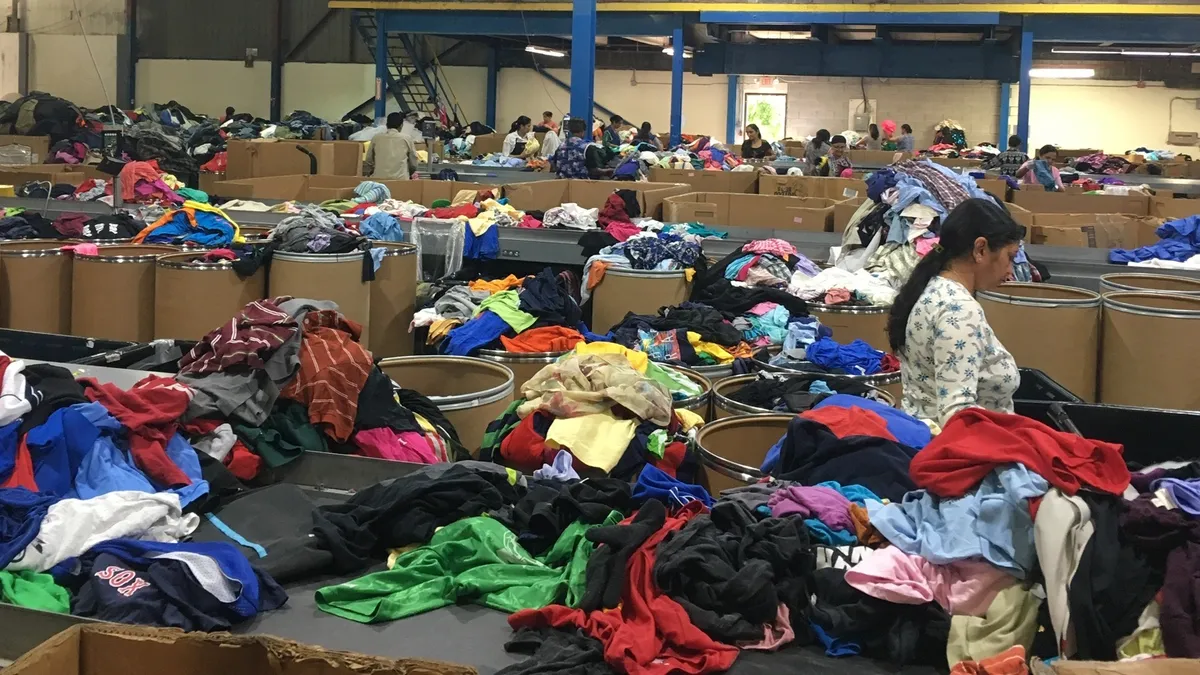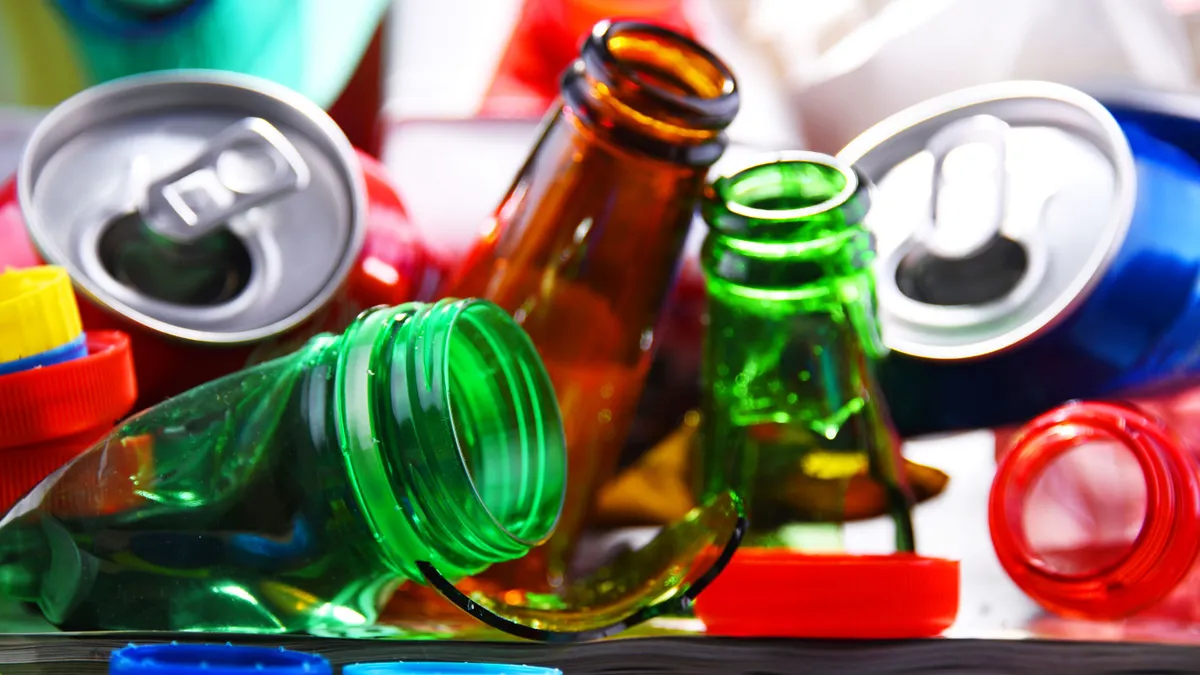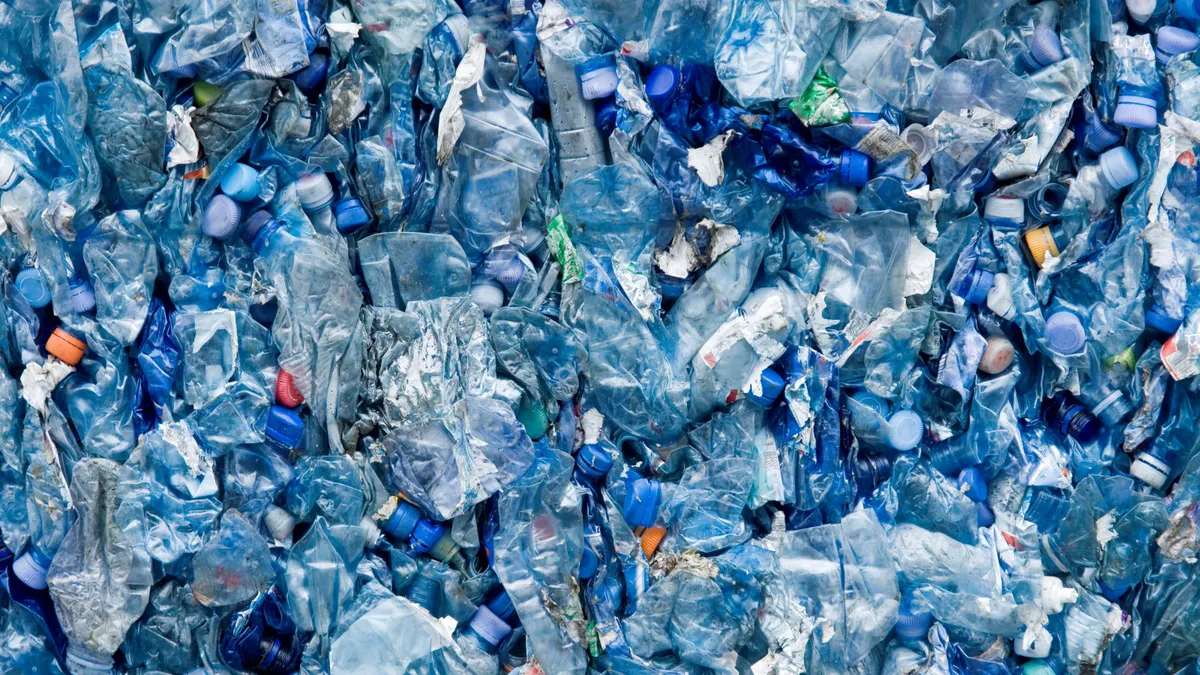Amid all the conversations about single-use plastics, food waste and other emerging cultural concerns, the amorphous category of "stuff" in our waste stream often goes overlooked. Adam Minter, a longtime recycling journalist who now writes for Bloomberg Opinion, has been on a multi-year journey to change that.
Following up on his 2013 debut "Junkyard Planet," which focused on the global scrap trade, Minter's newest work brings his signature mix of personal narratives and business reporting to the reuse sector. Traveling across multiple continents – from Goodwills in Arizona to the textile mills of Panipat, India – Minter chronicles a whole new side of the recycling economy in his book "Secondhand: Travels in the New Global Garage Sale."
Waste Dive recently spoke with Minter to learn about what his findings could mean for the future of waste and recycling in the United States and beyond.
The following conversation has been edited for brevity and annotated for context.
WASTE DIVE: We hear a lot of discussion about how reduction should fit into "zero waste" goals and other sustainability plans. That may not be a likely outcome based on consumer preferences, especially in developing countries where people want a chance to experience certain lifestyles. Are the calls for reduction going to work based on what you found reporting this?
ADAM MINTER: I've been living (in Asia) since 2002, and one of the things that I've learned here is that emerging consumers want to have their chance to consume. You have a massive emerging middle class out here who aren't yet receptive to a message that ... they're morally suspect for wanting to consume the way that Europeans or Japanese or Australians or Americans have. So I've come to see and come to believe that they are going to have their consumption cycle, they're going to enjoy it in all of its good and bad components.
The one thing that's happened in the U.S. is that people tend to look at consumption and consumer goods as a bad thing. I don't look at them necessarily as a bad thing. Better living standards are good for everybody. But there's also the dark side, as anybody in the waste and recycling industry can attest.
You start seeing the shoots of sustainable consumption already happening out here, especially in China, and that's happening much more quickly than it did in the developed economies like the United States. So I take encouragement from that, but you're talking about over a billion emerging market consumers. It's going to take quite a while for us to get to the point where people are up for waste reduction.
Secondhand's opening chapters focus on growing home clean-out industries, both in the U.S. and Japan, with a stark look at how little value there can be in the items people leave behind when they die. Aging populations in both countries have made these services increasingly necessary.
Japan's earlier experience with this trend, among other factors, has created a very robust and formalized reuse industry in the country. By comparison, the U.S. network of charitable organizations running thrift stories feels much different.
As you reported, Goodwill is a huge part of the U.S. reuse industry – bigger than some of the waste companies I cover based on revenue – but it just doesn't get the same attention. Do you think that we are going to hit a tipping point here in the United States, as our population ages out, where it somehow becomes more economically viable to have a thriving reuse industry like they do in Japan?
MINTER: The U.S. is such an unusual demographic case, because you have an aging, affluent society, which is something we see happening everywhere – from Korea to Sweden. And yet ... unlike most affluent economies, the United States still has a lot of immigrants who are demographically rich, meaning that they're having a lot of children. And those immigrants are, as I write in the book, a market for the secondhand reuse economy already. It just doesn't happen quite in the way that happens in Japan, where you have this very uniform demography.
In the United States you have a great deal of income inequality. The reuse business, at least as it comes down to secondhand consumer goods, is oftentimes a story of income inequality and goods sliding down the ladder. So even though it doesn't get much attention, there's massive amounts of reuse. You just have to go down to the Goodwills – especially in the southern United States, the Southwest – where you have large Hispanic immigrant populations. They are the majority shoppers at those Goodwills and those Salvation Armys and the other thrift stores. They are very much the secondhand economy that so many folks claim to want.
I think when you hear people talk about circular economies in the United States and in Europe, oftentimes they think that they're talking about a circular economy for the more affluent. That's a great thing and we certainly should have that. But we also need a circular economy that provides consumer goods to the less affluent, and that already exists.
It's not the job always of developing economies and lower-income people to be learning from the wealthy environmentalists in the West – most of whom are (white). In many cases it really is incumbent upon the wealthy environmentalists, in places like Europe that want circular economies, to start learning from lower-income economies where you already have very high rates of reuse and recycling, albeit informal.
The discussion turns to how a lack of hard data on the reuse sector might be part of the challenge with raising its profile. As Minter notes in his book, no one has found a way to track how many garage sales are happening around the country let alone how much revenue they're generating. He also points to common narratives about the majority of e-waste getting mishandled globally – including at the commonly cited Agbogbloshie scrapyard in Ghana – as an example of where data gaps and definitional differences fail to capture the full extent of recycling.
Is it not in the interests of some of these major brands now pushing "circular economy" goals to talk about reuse, or reduction? Many of them are funding lots of recycling initiatives, but secondhand doesn't really seem to have a place in that to keep their business going.
MINTER: That's exactly correct. Not only that, but some of these circular economy initiatives, to an extent, will compete with the informal recycling and reuse sector just by their very nature. When somebody in Europe says, "we want a circular economy for recycling and reusing computer components," that puts that policymaker, that entity, directly at odds with circular economies in reuse industries and recycling industries, in places like West Africa. (They) also want to use those computers and those components and those monitors, and they may actually use them more efficiently.
You definitely have this tension between the informal and the formal reuse sector. For better or worse the formal sector, at least in developed economies, has all the marketing muscle. It sort of has a free hand to depict the informal economies as they want. The informal economies really don't get much voice in this debate. They are depicted in one way, usually negatively.
What role do you see for policymakers or local governments in developed countries to help highlight those informal economies?
MINTER: One thing is simply to stop stigmatizing the reuse of developed world goods in developing countries. One of the reasons why in this book I concentrated so much on used clothing and used electronics is both of those trades have sort of been unfairly, in my opinion, tainted by depictions that emerge from places like the United States. There's something dirty about exporting your used computer to Ghana. There's something dirty about sending your used clothes to Kenya or Tanzania. I think it's worth unpacking why we feel that way. Why are we so threatened by the idea that somebody in an emerging market would be reusing our stuff, in many cases reusing it more efficiently than it's used in a developed market?
We don't so much have this problem in the United States, but in Europe in particular they've really institutionalized stigmas against exporting secondhand goods into developing countries. That's very unhelpful to the development of circular economies, because I think we're going to find out, whether we like it or not, circular economies don't work if they're just circulating around one country, or even one continent.
A question that's been raised often about the current open market system is how to ensure there's an even playing field in terms of environmental and labor standards. You've traveled a lot, far more than many of us have. Is there any way to do that?
MINTER: If the growth in consumption and in consumers is happening in emerging markets, then it's incumbent upon... the manufacturers of goods to start playing a role in end of life for those goods in emerging markets. That may take a number of different forms.
On the textile side, it may take the form of we are going to make more durable textiles, better clothes, that can be used longer. And when they do reach the end their life, they can be recycled, shredded and turned into (new products).
Or in the case of the electronics industry, which is what gets most of the attention, they're going to need to start thinking about takeback programs in emerging markets. Possibly installing electronic recycling, or at least disassembly, plants. We've seen some European recyclers actually go into emerging markets and start purchasing chips, different components and bringing them back to Europe for recycling. We need to see a lot more of that. How you set up a transnational (extended producer responsibility system), I don't know. Ultimately, I think that's going to be incumbent upon a lot of these emerging economies which, frankly, don't have the ability to regulate that sort of thing yet. So, ultimately, I think it's going to come down to corporate responsibility.
Minter points to China's multi-year efforts to create market-oriented EPR systems, particularly for electronics, as "a model that you could see spread throughout Asia and hopefully into other places."
While textiles and electronics can still be valuable commodities in the right circumstances, "Secondhand" also spotlights the immensity of other goods that are often far less valuable.
There's striking examples you had from the Goodwill warehouse in Arizona of what you were seeing in the containers heading off to the landfill, stuff that nobody really wants. Is there some stuff that's just never going to be that valuable in the secondhand economy?
MINTER: I think the problem is that so many of the goods that we buy and consume these days are really single-use items. The IKEA bookshelf is a perfect example.
You can assemble it in your home, but then you talk to movers, you talk to the Salvation Army, you talk to Goodwill, those are just not sellable. They are just not a commodity. They break when you move them and ultimately they're going to end up in the landfill or an incinerator. And the IKEA bookshelf is really just one item that can serve as a model and example across different product types.
You get these children's toys that have multiple types of plastic on them, there's simply simply no way to recycle them. And at a certain point nobody wants to buy a broken toy. I'm frankly, as a parent, more concerned about plastic toys at this point than I am about plastic bags.
I don't think we as a consumer society, and this goes beyond the United States, are really at a point where we're seriously looking at what's going into the landfills yet and what's going into the incinerators.
U.S. Environmental Protection Agency data from 2015 says furniture alone accounted for 4.6% of the waste stream in 2015. "Miscellaneous durables," including consumer electronics, comprised another 8.7%. Waste generation from textiles, such as clothing, represents even more volume in another category.
A combination of lower-quality, "fast fashion" garments, coupled with changing market demands in other countries, is reshaping the textile recycling market. As outlined in Minter's travels from a rag-making business in Ohio to a major textile hub in Canada to mills in India and secondhard markets in Nigeria, the scope of this sector is significant.
Curbside textile pick-up is becoming more of a trend in certain U.S. states, including where I live, in Massachusetts. Companies often offer the service for free to municipalities, in part because they can make money off other non-textile items in the bags. Do you view that as a sustainable model, given what's happening with global textile markets shifting?
MINTER: One of the things that really shocked me in writing the book was how much the value of secondhand textiles is collapsing because of the huge flood of textiles coming into the market. Not just from fast fashion in the United States and Europe, but because of all the stuff coming now from consumers in Asia.
Within all of that – much of it being of no interest in the secondhand market, because there's so much and because it's just very badly made – there are still well-made garments within those bales. And those well-made garments can finance a lot of landfilling of garments that nobody wants. And so I think for the time being those (curbside programs) are viable models.
But, Minter notes, growing amounts of textile waste from China, India and especially African countries could change that whole dynamic in the future.
When they start generating their own clothing waste, you're going to have reached a point where there just isn't a market for this traditional model of donation that's kept clothing recycling going for so many years.
For many people in the traditional waste and recycling industry, it seems like much of this often gets viewed as outside our world. Any recommendations on how to get more up to speed on the reuse industry?
MINTER: It is part of their world. The landfill operators are absolutely going to be dealing with increasing volumes of textile waste, furniture waste, just people's household belonging waste as the baby boomers start downsizing. There's just not a big enough secondhand market for all that stuff to go into Goodwills and other people's homes. A good chunk of it is going to end up in recycling centers and landfills. So they need to be paying attention to that.
One of the things that I found really interesting in researching this book is what an extraordinary civic resource Goodwill in particular is. If we didn't have Goodwill, I think local governments would want to invent it. Because it's not only doing something that desperately needs to be done, which is promoting reuse within communities, it's actually an incredible repository of knowledge of what kinds of things are entering the waste stream at a very early stage.
I think there's a lot of operators, governments and private companies, that could really learn a lot from them. And I think it would do us all a lot of good if they did.


















